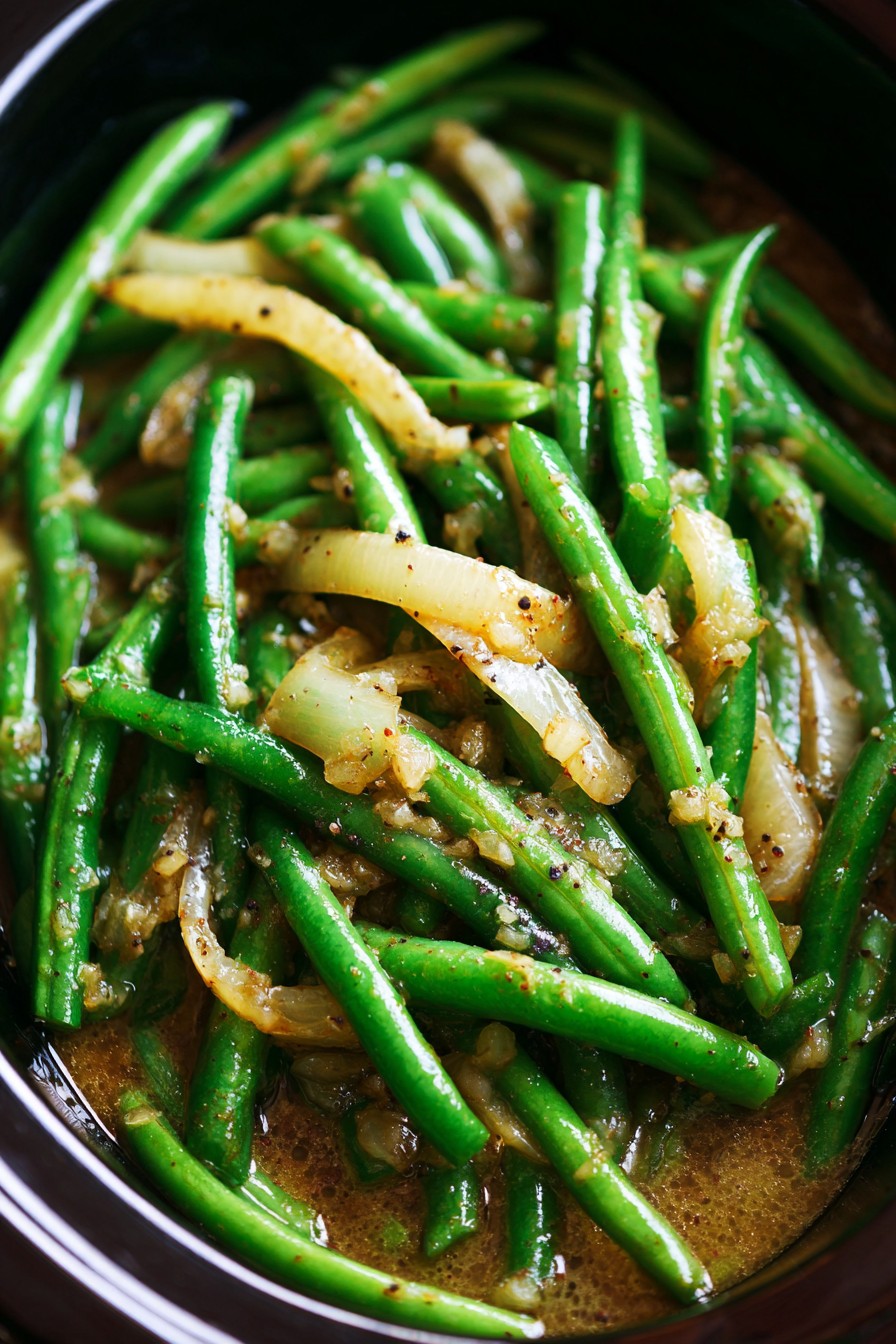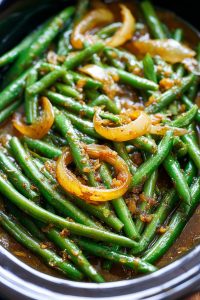Global flavors converge in this humble crockpot dish that transforms simple green beans into a culinary journey. Growing up between my grandmother’s Southern kitchen and the vibrant markets of Southeast Asia, I discovered how slow cooking can weave cultural threads into everyday meals. Green beans, often overlooked, become tender ambassadors of comfort when given time to absorb the complex notes of garlic, soy, and aromatic spices.
Why This Recipe Works
- The slow cooker method allows green beans to develop deep, concentrated flavors while maintaining their structural integrity, much like the traditional French haricots verts simmered in herbed broths for hours.
- Combining soy sauce with smoked paprika creates an umami-rich base that bridges Eastern and Western culinary traditions, reminiscent of Spanish judías verdes con jamón but with Asian-inspired complexity.
- Low-temperature cooking preserves the beans’ vibrant green color while transforming their texture from crisp to meltingly tender, similar to Italian fagiolini stufati cooked slowly with tomatoes and herbs.
- The addition of brown sugar caramelizes during the extended cooking time, creating a subtle sweetness that balances the savory elements, echoing the sweet-savory balance found in many Middle Eastern vegetable dishes.
- Using chicken broth as the cooking liquid infuses the beans with rich, savory depth while keeping them moist throughout the extended cooking process, much like Greek fasolakia lathera where vegetables simmer slowly in olive oil and tomato sauce.
Ingredients
- 2 pounds fresh green beans, trimmed and washed
- 1 large yellow onion, thinly sliced
- 4 cloves garlic, minced
- 1/4 cup low-sodium soy sauce
- 2 tablespoons olive oil
- 1 tablespoon brown sugar
- 1 teaspoon smoked paprika
- 1/2 teaspoon black pepper
- 1 cup chicken broth
- 2 tablespoons butter, cubed
Equipment Needed
- 6-quart or larger slow cooker
- Cutting board
- Chef’s knife
- Measuring cups and spoons
- Mixing spoon
Instructions

Prepare the Aromatic Foundation
Begin by creating the flavor base that will transform your green beans. Thinly slice one large yellow onion, allowing it to separate into delicate half-moons that will melt into the cooking liquid. Mince four cloves of fresh garlic until they reach a fine, paste-like consistency that will distribute evenly throughout the dish. In a small bowl, whisk together the quarter cup of soy sauce, two tablespoons of olive oil, one tablespoon of brown sugar, one teaspoon of smoked paprika, and half teaspoon of black pepper until the sugar completely dissolves and the spices form a harmonious emulsion. This initial preparation mirrors the mise en place technique used in professional kitchens worldwide, ensuring each component is ready to contribute its unique character to the final dish. The smoked paprika adds a subtle smokiness reminiscent of Spanish cuisine, while the soy sauce brings the umami depth characteristic of Asian cooking.
Layer the Ingredients Strategically
Create your flavor foundation by placing the trimmed and washed green beans in the slow cooker, arranging them in an even layer that allows for consistent cooking. Scatter the thinly sliced onions over the beans, followed by the minced garlic, distributing them evenly to ensure every bite contains the aromatic trio. Pour the prepared soy sauce mixture over the vegetables, using a spoon to gently toss and coat the beans, taking care not to break them. The layering technique here is crucial—it allows the onions and garlic to caramelize slowly while infusing the beans with their flavors, much like the traditional French technique of étuvée where vegetables cook slowly in their own juices. Tip: For extra flavor dimension, consider lightly toasting the smoked paprika in a dry pan for 30 seconds before adding it to the sauce mixture—this technique, borrowed from Mexican mole preparation, deepens the spice’s complexity.
Add Liquid and Begin Cooking
Pour one cup of chicken broth over the seasoned green beans, ensuring the liquid reaches about halfway up the vegetable layer without completely submerging them. The broth should create a steaming environment rather than boiling the beans, preserving their texture while allowing flavors to meld. Place the two tablespoons of cubed butter evenly across the top—this will melt slowly and create a rich, glossy sauce as the beans cook. Cover the slow cooker with its lid and set the temperature to low for 6 hours. This extended cooking time allows the beans to become fork-tender while absorbing the complex flavors, similar to how Mediterranean vegetables slow-cook in clay pots. The low temperature ensures the beans don’t become mushy, maintaining just enough bite to recall the al dente texture prized in Italian vegetable preparations.
Monitor and Adjust Midway
After three hours of cooking, carefully remove the lid—being mindful of the steam—and gently stir the green beans to redistribute the cooking liquid and ensure even flavor distribution. Check the liquid level; if it appears too reduced, add two tablespoons of additional chicken broth to maintain the steaming environment. At this stage, the beans should be beginning to soften but still retain some crispness, similar to Chinese restaurant-style green beans that maintain texture despite extended cooking. Use a fork to test tenderness—they should yield with slight resistance, not complete mush. This midway check is crucial for achieving the perfect texture balance, much like the attention given to Indian sabzi preparations where vegetables must be cooked through while maintaining structural integrity.
Final Cooking and Texture Assessment
Return the lid and continue cooking for the remaining three hours. During the final hour, the beans will reach their peak tenderness while the cooking liquid reduces to create a flavorful sauce. Test for doneness by pressing a bean against the side of the slow cooker—it should collapse easily but not disintegrate. The finished texture should resemble Turkish taze fasulye, where green beans become meltingly tender while maintaining their shape. The sauce should have thickened slightly from the natural starches released by the beans and the reduction of the cooking liquid. Tip: For a more intense flavor, during the last 30 minutes of cooking, you can prop the lid open slightly with a wooden spoon to allow for additional reduction, a technique often used in French cooking to concentrate sauces.
Rest and Serve
Once the cooking time is complete, turn off the slow cooker and let the green beans rest for 15 minutes with the lid slightly ajar. This resting period allows the beans to absorb any remaining liquid and the flavors to fully integrate, much like how Middle Eastern stews benefit from a brief rest before serving. The residual heat will continue to gently cook the beans while the sauce thickens to the perfect consistency. Use a slotted spoon to transfer the beans to a serving dish, then drizzle with the reduced cooking liquid from the bottom of the slow cooker. The finished dish should glisten with the reduced, flavorful sauce that clings to each bean. Tip: For added freshness and visual appeal, garnish with a sprinkle of chopped fresh parsley or toasted sesame seeds just before serving, echoing the finishing touches found in both European and Asian culinary traditions.
Tips and Tricks
For those seeking to elevate this already flavorful dish, consider these advanced techniques drawn from global culinary traditions. When selecting green beans, look for the slender haricot vert variety if available—their delicate texture and sweeter flavor profile absorb the slow-cooked seasonings more effectively than thicker common beans. For an extra layer of complexity, toast whole cumin seeds and coriander seeds in a dry pan until fragrant, then grind them finely and add to the seasoning mixture; this technique, borrowed from Indian tadka preparations, releases essential oils that transform during the slow cooking process. If you prefer a thicker sauce, during the final hour of cooking, create a slurry by mixing one tablespoon of cornstarch with two tablespoons of cold water, then stir it into the cooking liquid—this Chinese-inspired technique will give you a glossy, clingy sauce that coats each bean beautifully.
For meat lovers seeking additional protein, rendered pancetta or bacon bits can be added during the initial layering stage—the fat will slowly render and infuse the beans with smoky richness reminiscent of Southern American cooking. Vegetarians can achieve similar depth by adding dried shiitake mushrooms to the cooking liquid; their potent umami compounds will extract during the extended cooking time, creating a meat-free alternative with incredible flavor complexity. If you’re cooking for a crowd and need to double the recipe, maintain the same liquid proportions but extend the cooking time by one hour to ensure the larger volume reaches perfect tenderness. For those who enjoy textural contrast, reserve a handful of raw green beans, blanch them briefly in boiling water, and add them during the final 30 minutes of cooking—this Japanese-inspired technique provides a pleasant crunch alongside the meltingly tender slow-cooked beans.
Storage and reheating require special attention to maintain quality. The beans can be refrigerated for up to four days in an airtight container, and their flavors often improve overnight as the seasonings continue to meld, much like many stews and braised dishes from various cultures. When reheating, use a covered saucepan over low heat with a tablespoon of additional broth to prevent drying out—microwaving can make the beans rubbery and compromise their carefully developed texture. For freezing, portion the cooled beans with their sauce into freezer-safe containers, where they’ll maintain quality for up to three months; the slow-cooked texture holds up remarkably well to freezing and thawing, unlike quickly cooked vegetables that become watery when frozen.
Recipe Variations
- Mediterranean Twist: Replace soy sauce with lemon juice and olive oil, add Kalamata olives, sun-dried tomatoes, and oregano for a Greek-inspired version that echoes the flavors of traditional fasolakia. The briny olives and tangy tomatoes create a bright counterpoint to the tender beans, while fresh oregano adds the characteristic aroma of the Mediterranean coastline. Serve this variation with feta cheese crumbled over the top and crusty bread for soaking up the flavorful juices.
- Asian Fusion: Incorporate sesame oil instead of olive oil, add ginger slices, and finish with a drizzle of chili crisp for a Szechuan-inspired dish that brings heat and numbing sensation. The ginger adds warming notes that complement the slow-cooked beans, while the chili crisp provides textural contrast and vibrant heat. Garnish with toasted sesame seeds and sliced scallions to complete this East-meets-West creation that would feel at home in any modern Asian fusion restaurant.
- Southern Comfort: Add diced ham or bacon, use apple cider vinegar instead of soy sauce, and include a pinch of red pepper flakes for a down-home version reminiscent of traditional Southern green beans. The smoky pork products render their fat into the cooking liquid, creating rich depth, while the vinegar cuts through the richness with its bright acidity. This variation particularly benefits from extended cooking time, allowing the beans to absorb every bit of the pork-infused flavor.
- French Provençal: Use herbes de Provence instead of smoked paprika, white wine instead of chicken broth, and finish with chopped fresh tarragon for an elegant take on haricots verts à la Provençale. The herbal complexity of the Provençal seasoning blend transforms the humble green beans into a sophisticated side dish worthy of any French bistro. The white wine adds fruity notes that brighten the dish, while fresh tarragon provides the characteristic anise-like finish that defines this regional cuisine.
Frequently Asked Questions
Can I use frozen green beans instead of fresh?
While fresh green beans provide the best texture and flavor absorption, frozen beans can work in a pinch with some adjustments. Frozen beans contain more water, so you’ll need to reduce the chicken broth to 3/4 cup to prevent the dish from becoming watery. They’ll also cook slightly faster, so check for doneness after 5 hours rather than 6. The texture will be somewhat softer than with fresh beans, but they’ll still absorb the flavors beautifully. This adaptation follows the same principle as many frozen vegetable preparations in international cuisines, where adjustments to liquid and cooking time account for the different moisture content.
What if I don’t have 6 hours to slow cook?
For a faster version that still develops deep flavors, you can cook the beans on high for 3-4 hours, though the texture will be slightly different. The higher temperature causes the beans to cook more quickly but doesn’t allow for the same gradual flavor development. To compensate, consider sautéing the onions and garlic in the olive oil before adding them to the slow cooker—this initial browning, common in many quick-cooked vegetable dishes from various cultures, creates flavor foundations that normally develop during extended cooking. The beans will be tender but may lack the melting quality achieved with slower cooking.
Can I make this recipe vegetarian or vegan?
Absolutely—this recipe adapts beautifully to plant-based diets. Replace the chicken broth with vegetable broth and use vegan butter or additional olive oil instead of regular butter. For enhanced umami without animal products, add a tablespoon of miso paste to the seasoning mixture or include a few dried porcini mushrooms in the cooking liquid. These substitutions create a deeply savory profile that rivals the original, drawing on techniques from Japanese and Italian vegetarian cooking where mushroom-based broths and fermented products provide the depth typically associated with meat-based stocks.
How do I prevent the green beans from becoming mushy?
Preventing mushiness requires attention to bean selection, liquid amount, and cooking time. Choose fresh, firm green beans without visible wrinkles or soft spots—they should snap crisply when bent. Ensure the cooking liquid doesn’t completely cover the beans; they should steam rather than boil. Check for doneness beginning at the 5-hour mark—the beans are ready when tender but still offer slight resistance. This approach mirrors techniques used in Chinese restaurant cooking where green beans are often blanched then quickly stir-fried to maintain crisp-tender texture, adapted here for slow cooking.
Can I add other vegetables to this recipe?
This recipe serves as an excellent base for additional vegetables, though timing considerations are important. Root vegetables like carrots or potatoes should be added at the beginning as they require extended cooking similar to the beans. Quick-cooking vegetables like bell peppers or zucchini are best added during the final 2 hours to prevent them from becoming too soft. Mushrooms can be added at any stage—early for deeper flavor integration or later for firmer texture. This layered approach to vegetable cooking is common in many international stews and braises where different ingredients require different cooking times to achieve perfect doneness.
Summary
This crockpot green bean recipe transforms simple ingredients into globally inspired comfort food through slow cooking. The method yields tender beans infused with complex flavors that bridge culinary traditions while maintaining perfect texture. Versatile and deeply satisfying, it demonstrates how patience and thoughtful seasoning can elevate everyday vegetables.



